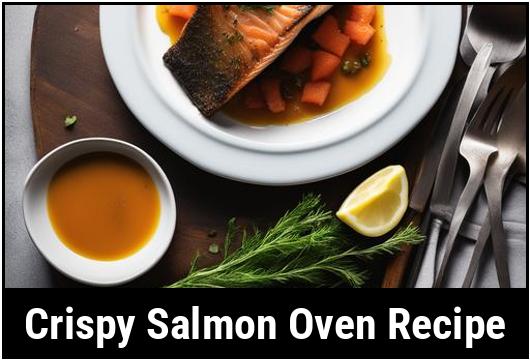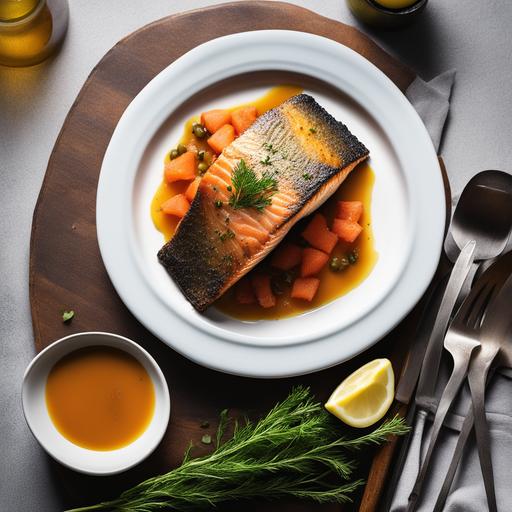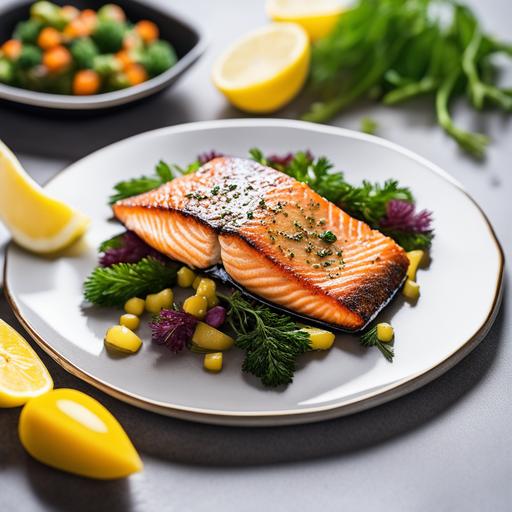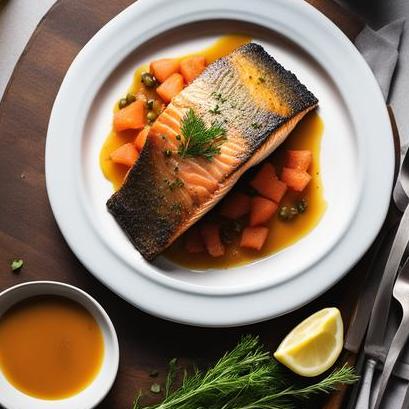
The Crispy Salmon Oven Recipe: Unlocking The Perfect Blend Of Flavor And Texture
Are you a seafood enthusiast longing for a delightful meal that combines delicate flavors with a satisfying crunch? Look no further than the Crispy Salmon Oven Recipe! This exquisite dish boasts a harmonious combination of tender, flaky salmon with a delectably crispy exterior, making it a favorite among food connoisseurs. Drawing inspiration from scientific food principles and culinary expertise, this comprehensive guide will navigate you through everything you need to know about this mouthwatering recipe. From selecting the finest salmon to experimenting with variations and tips to ensure the perfect cook, we have got you covered!
Understanding the Food Science Behind Crispy Salmon
Before diving into the specifics of cooking the perfect crispy salmon, it’s essential to explore the science behind achieving that heavenly texture and flavor. Cooking salmon, a dense fish with a relatively high fat content, requires a delicate balance to ensure a crisp exterior without sacrificing its moistness.
The Role of Fat Content and Proteins
Salmon’s high fat content plays a crucial role in achieving the desired texture. When exposed to high heat, the fat renders, resulting in a crispy, golden crust. Meanwhile, the proteins present in the salmon undergo denaturation—a process where the proteins change structure. This change leads to the formation of a desirable brown crust on the salmon’s exterior.
Heat Transfer and Maillard Reaction
To achieve a crisp exterior while keeping the interior tender, a delicate dance of heat transfer must take place. The Maillard reaction is key to this process. It involves the reaction between amino acids and reducing sugars present in the salmon’s surface, resulting in the distinctive flavors and beautiful brown crust. A hot oven temperature ensures this reaction occurs at the right pace, allowing for a crispy yet moist salmon.
Selecting the Finest Salmon: A Journey of Quality and Freshness
As with any culinary masterpiece, the foundation lies in choosing the finest ingredients. When it comes to the crispy salmon oven recipe, selecting the right salmon is of utmost importance to guarantee a memorable dining experience. Follow these guidelines to ensure you get the best quality fish:
Opting for Freshness
Freshness is of paramount importance when it comes to seafood. Look for salmon fillets that have a vibrant, pink hue. The flesh should appear firm and resilient to the touch. Avoid any fish with an off-putting odor, as this indicates deterioration.
Sourcing Sustainable Salmon
Being mindful of sustainability is not only crucial for the environment but also results in better-tasting salmon. Choose salmon that comes from sustainable sources, such as wild-caught Alaskan salmon or responsibly farmed varieties. These options are not only more environmentally friendly but also tend to have superior flavor and texture.
The Path to a Clean Canvas: Cleaning the Salmon Fillets

Before embarking on the culinary journey of preparing the crispy salmon, it is vital to clean the fillets thoroughly. Properly cleaning the salmon ensures the removal of any lingering impurities, ensuring a fresh and delectable end result:
Rinsing Under Cold Water
Start by gently rinsing the salmon fillets under cold running water. This step helps get rid of any loose scales or debris that may have adhered to the fish’s surface. Use your fingertips to remove any stubborn scales, ensuring a smooth canvas for the flavors to shine.
Patting Dry for Optimal Browning
Once rinsed, gently pat the salmon fillets dry using a paper towel. Excessive moisture on the surface inhibits browning, resulting in a less crispy finish. By ensuring the fillets are adequately dried, you set the stage for achieving that coveted golden crust.
Mastering the Art of Preparation: Techniques and Tips

With the selection and cleaning phase complete, let’s dive into the art of preparing the crispy salmon. Follow these culinary techniques and insider tips to elevate your dish and guarantee delectable results.
Score the Skin for Extra Crispiness
Scoring the salmon skin not only adds a visually appealing touch but also enhances the crispiness. To achieve this, use a sharp knife to make shallow diagonal cuts in the skin. Be careful not to cut through the flesh. This technique promotes even cooking and prevents the skin from curling up during the cooking process.
Seasoning for Flavorful Delights
The seasoning plays a pivotal role in elevating the taste profile of the crispy salmon. Opt for a combination of flavors that complement the fish without overpowering it. A classic choice includes a blend of salt, black pepper, and a twist of lemon zest. Get creative and experiment with other herbs and spices such as dill, paprika, or garlic powder to add depth and variety to your salmon.
The Perfect Coating for Extra Crunch
To achieve an irresistibly crunchy exterior, a coating comes into play. Some popular options include breadcrumbs, panko, or even crushed cornflakes. The coating not only adds texture but also acts as a barrier, ensuring the salmon retains its moisture during the cooking process. Lightly press the salmon fillets into the coating mixture, evenly distributing it for consistent crunchiness.
Utilize a Wire Rack for Optimal Air Circulation
When baking the salmon, elevate it using a wire rack placed on a baking sheet. This setup allows for better airflow all around the fillets, leading to a more uniform and crispy texture. The hot air can circulate freely, ensuring the salmon cooks evenly while maintaining its crunch.
Checking for Doneness: A Journey Towards Perfection

To guarantee a perfectly cooked crispy salmon, understanding the appropriate doneness is crucial. Overcooking can result in dry and tough flesh, while undercooking may leave the fish raw and lacking in flavor. Here are some essential tips to achieve the ideal doneness:
The Flaky Texture Test
An excellent indicator of doneness is the fish’s flakiness. Once the salmon fillets turn opaque and can be easily flaked with a fork, they are likely perfectly cooked. However, be mindful not to overcook the fish as it will continue cooking for a short period after being removed from the oven.
The Target Internal Temperature
For precision, use an instant-read thermometer to measure the salmon’s internal temperature. According to the FDA guidelines, the salmon should reach an internal temperature of 145°F (63°C). At this point, it is safely cooked without sacrificing its tenderness and flavor.
Resting for Flavorful Results
Allow the cooked salmon to rest for a few minutes before serving. Resting allows the juices to redistribute within the fillets, resulting in a more succulent and flavorful bite. Take this opportunity to gather your loved ones, set the table, and bask in the anticipation of savoring this culinary masterpiece.
Embracing Variations: Creativity in the Kitchen

While the classic crispy salmon recipe is undoubtedly tantalizing, don’t be afraid to unleash your creativity in the kitchen. Here are a few variations to inspire your culinary adventures:
Asian-Inspired Glazes
Experiment with vibrant glazes inspired by Asian cuisine. Teriyaki, hoisin, or a combination of soy sauce, honey, and ginger can add a delightful twist to your crispy salmon.
Herbaceous Infusions
Incorporate fresh herbs into your recipe for an added burst of flavor. From rosemary-infused oil to a fragrant mix of thyme, basil, and oregano incorporated into the coating, herbs bring a touch of sophistication to the dish.
Citrus Zest and Juices
Brighten up the flavors by using different citrus zest and juices. Orange, lime, or grapefruit can provide a tangy kick that complements the salmon’s richness.
Overcoming Obstacles: Tips to Avoid Overcooking or Undercooking
While mastering the crispy salmon oven recipe is a journey of culinary exploration, it is not without its challenges. The following tips will help you avoid undercooking or overcooking your salmon, ensuring consistent, delicious results:
Monitoring Cooking Time
Keep a close eye on the cooking time to prevent either undercooking or overcooking the salmon. Adapt the time according to the thickness of the fillets. Thicker cuts may require more time, while thinner ones cook faster. Regularly checking for desired doneness using the techniques mentioned earlier will keep you on track.
An Oven Thermometer for Temperature Accuracy
Ensure your oven temperature is accurate by using an oven thermometer. Oven thermostats can vary, leading to inconsistencies in cooking. A reliable oven thermometer provides a foolproof way to achieve the desired cooking temperature and prevent undercooking or overcooking mishaps.
Adjusting Racks for Even Cooking
If you notice uneven cooking during the baking process, adjust the oven racks accordingly. Relocate the salmon fillets to ensure they are receiving an equal amount of heat from all sides. This simple adjustment can make a significant difference in achieving an evenly crispy and succulent outcome.
The Perfect Crispy Salmon Oven Recipe
Now that you are well-equipped with a wealth of knowledge, it’s time to put it all together and embark on your culinary journey. Here’s a comprehensive recipe to guide you towards achieving the perfect crispy salmon:
Ingredients:
-
Fresh salmon fillets, preferably skin-on
-
Salt
-
Black pepper
-
Lemon zest
-
Olive oil
-
Breadcrumbs (or desired coating)
-
Optional: Fresh herbs, spices, or glazes of your choice
Instructions:
-
Preheat your oven to 425°F (220°C).
-
Line a baking sheet with foil or parchment paper for easy cleanup.
-
Rinse the salmon fillets gently under cold running water and pat them dry with a paper towel.
-
Score the skin of each fillet with shallow diagonal cuts to promote even cooking and prevent curling.
-
Season the salmon with salt, black pepper, and lemon zest (or any desired herbs and spices) on both sides, ensuring even coverage.
-
If using a coating, lightly press the salmon fillets into the breadcrumbs, or your preferred coating, ensuring all sides are covered.
-
Place a wire rack on top of the prepared baking sheet and arrange the seasoned salmon fillets on the wire rack.
-
Drizzle olive oil over the salmon fillets, ensuring they are lightly coated.
-
Place the baking sheet on the center rack of the preheated oven and bake for approximately 12-15 minutes, or until the salmon reaches an internal temperature of 145°F (63°C). Keep monitoring the fillets for desired doneness throughout the cooking process.
-
Once cooked, remove the salmon from the oven and let it rest for a few minutes before serving.
-
Garnish with fresh herbs or a squeeze of lemon juice for an extra burst of flavor.
-
Serve your crispy salmon alongside your favorite side dishes and revel in the culinary masterpiece you have created!
Conclusion: Unlocking the Art of the Perfect Crispy Salmon
Dubbed a culinary delight by seafood enthusiasts worldwide, crispy salmon oven recipe combines the delicate flavors of the sea with a satisfying crunch. Understanding the science behind achieving the perfect texture, selecting the finest ingredients, and mastering the techniques involved sets the stage for a truly remarkable dish. Whether you savor its classic form or venture into creative variations, the crispy salmon captivates palates with its harmonious blend of flavors and textures. Utilize the comprehensive tips, techniques, and recipe presented in this guide to embark on a culinary journey that will leave you and your loved ones craving more. Let the art of crispy salmon elevate your dining experience and become the centerpiece of your culinary repertoire.
Sources
FAQS On Crispy Salmon Oven Recipe
What Type Of Salmon Is Best For A Crispy Salmon Oven Recipe?
Coho, Chinook, and Sockeye salmon are all great options for this recipe.
Do I Need To Cook The Salmon With The Skin On Or Off?
Leaving the skin on while cooking can help protect the delicate flesh and provide extra flavor. However, if you prefer to remove the skin, that is perfectly fine as well.
How Long Should I Cook The Salmon In The Oven For It To Become Crispy?
It typically takes about 15-20 minutes to cook salmon in the oven until it is crispy on the outside but still juicy and tender on the inside. The exact cooking time will depend on the thickness of the fillet and your personal preference.
What Are Some Seasoning Options For A Crispy Salmon Oven Recipe?
A simple combination of salt, pepper, and olive oil is a classic seasoning option for salmon. You could also try adding fresh herbs like dill or thyme, or a sprinkle of lemon zest for extra flavor.
Is It Necessary To Marinate The Salmon Before Cooking?
While it’s not necessary to marinate the salmon before cooking, you may want to try making a quick marinade using ingredients like soy sauce, honey, and ginger to infuse the fish with extra flavor. Allow the salmon to sit in the marinade for 30 minutes before cooking for the best results.



